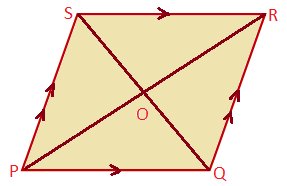Subscribe to our ▶️ YouTube channel 🔴 for the latest videos, updates, and tips.
Diagonals of a Parallelogram Bisect each Other
Here we will discuss about the diagonals of a parallelogram bisect each other.
In a parallelogram, diagonals bisect each other and each diagonal bisects the parallelogram into two congruent triangles.
Given: PQRS is a parallelogram in which PQ ∥ SR and PS ∥ QR. Its diagonals PR and QS cut each other at O.
To prove: (i) ∆PQR ≅ ∆RSP, ∆PQS ≅ ∆RSQ.
(ii) OP = OR, OQ = OS.
Proof:
|
Statement (i) In ∆PQR ≅ ∆RSP 1. ∠QPR = ∠PRS 2. ∠QRP = ∠RPS 3. PR = PR 4. ∆PQR ≅ ∆RSP. Similarly, ∆PQS ≅ ∆RSQ. (Proved) |
Reason 1. PQ ∥ SR and PR is a transversal. 2. PS ∥ QR and PR is a transversal. 3. Common side. 4. By ASA criterion of congruency. |
|
(ii). In ∆OPQ ≅ ∆ORS 5. PQ = RS 6. ∠QPO = ∠ORS 7. ∠PQO = ∠RSO 8. ∆OPQ ≅ ∆ORS. Therefore, OP = OR, QO = OS (Proved). |
5. CPCTC from statement 4. 6. PQ ∥ SR and PR is a transversal. 7. PQ ∥ SR and QS is a transversal. 8. By SAS criterion of congruency. CPCTC. |
From Diagonals of a Parallelogram Bisect each Other to HOME PAGE
Didn't find what you were looking for? Or want to know more information about Math Only Math. Use this Google Search to find what you need.



New! Comments
Have your say about what you just read! Leave me a comment in the box below. Ask a Question or Answer a Question.